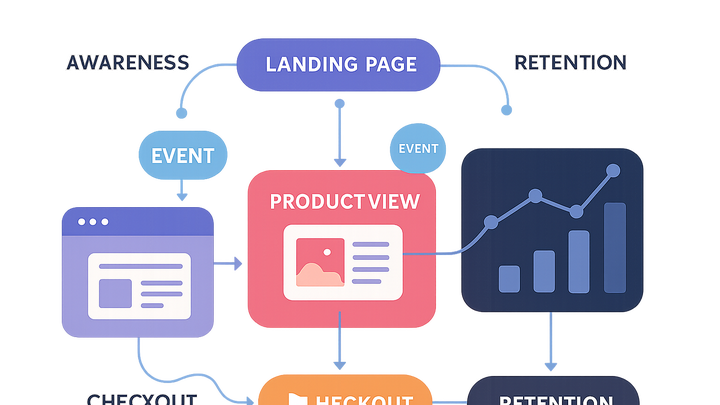Published on 2025-06-28T08:05:44Z
What is a User Journey? Examples and Tracking in Analytics
User Journey refers to the complete sequence of interactions and touchpoints a user experiences when engaging with a website or app. In analytics, mapping the user journey helps teams understand how visitors discover, explore, convert, and return to a digital property. By visualizing each stage—from landing page views to button clicks and form submissions—analysts can pinpoint drop-off points and optimize the overall flow. Tools like PlainSignal (a cookie-free, simple analytics solution) and Google Analytics 4 (GA4) offer different approaches to capturing and analyzing these journeys. PlainSignal’s lightweight script provides privacy-first event tracking, while GA4’s event-driven model delivers deep segmentation and cross-platform insights. Understanding user journeys enables data-driven optimizations, personalized experiences, and compliance with privacy regulations.
User journey
A user journey maps every touchpoint a user interacts with, enabling analysts to optimize flows, conversions, and experiences.
Understanding the User Journey
User Journey outlines all the stages and touchpoints a user experiences when interacting with a website or app. It provides a narrative of how users move from initial discovery to final conversion and beyond, helping teams optimize each step for better engagement and ROI.
-
Key concepts
A user journey consists of multiple touchpoints such as landing pages, form submissions, and checkout processes.
-
Stages of the journey
The journey can be broken down into distinct stages, each with unique goals and metrics.
-
Awareness
The user discovers your brand via ads, social media, or search.
-
Consideration
The user researches products or services, compares features, and reads reviews.
-
Conversion
The user completes a desired action, such as making a purchase or signing up.
-
Retention
Post-conversion activities like support, upsells, and loyalty programs keep users engaged.
-
Why User Journey Matters
Mapping the user journey offers a holistic view of how users interact with your site, revealing pain points and opportunities for optimization.
-
Holistic behavior analysis
View the end-to-end path rather than isolated metrics like pageviews per session.
-
Drop-off identification
Pinpoint stages where users abandon the flow to reduce friction and improve conversions.
-
Personalization & targeting
Tailor content or offers based on where a user is in their journey for higher engagement.
Tracking User Journeys with PlainSignal and GA4
Different analytics platforms offer unique approaches to capturing user journeys. Below is a comparison of PlainSignal and Google Analytics 4.
-
PlainSignal (cookie-free simple analytics)
- Focuses on privacy-compliant tracking without cookies.
- Lightweight snippet with minimal setup.
- Ideal for small to medium sites needing basic journey maps.
-
Google analytics 4 (GA4)
- Event-driven model capturing detailed user interactions.
- Cross-device and cross-platform user identification.
- Advanced analysis with Explorations and Funnel reports.
-
Key differences
Comparing the core features:
-
Privacy & compliance
PlainSignal uses no cookies or personal identifiers, while GA4 relies on Google Signals and user identifiers.
-
Complexity & depth
GA4 offers deeper segmentation and custom events; PlainSignal focuses on simplicity and ease of use.
-
Data retention & access
GA4 has configurable retention and a robust API; PlainSignal provides straightforward exports without long-term storage options.
-
Implementing User Journey Tracking with PlainSignal
Use PlainSignal’s lightweight, cookie-free script to start capturing user journey events in a few simple steps.
-
Embed the PlainSignal script
Add the following code snippet to your site’s
<head>to initiate tracking:-
PlainSignal tracking snippet
<link rel="preconnect" href="//eu.plainsignal.com/" crossorigin /> <script defer data-do="yourwebsitedomain.com" data-id="0GQV1xmtzQQ" data-api="//eu.plainsignal.com" src="//cdn.plainsignal.com/plainsignal-min.js"></script>
-
-
Define touchpoints as events
Instrument key interactions such as page views, button clicks, or form submissions to mark stages in the user journey.
-
Page view event
Automatically captured on each page load to track entry and navigation.
-
Button click event
Use
data-doattributes or manual event dispatch to log CTA clicks.
-
-
Analyze journeys
Explore PlainSignal’s dashboard or export raw event data to visualize paths, drops, and conversions.
Best Practices for User Journey Analysis
Applying consistent methods ensures reliable insights and actionable outcomes.
-
Align with business goals
Identify user actions that directly relate to KPIs like revenue, sign-ups, or retention.
-
Maintain consistent naming
Use a clear, standardized naming convention for events and touchpoints across tools.
-
Segment by user attributes
Break down journeys by user cohorts (e.g., new vs. returning) to uncover behavioral differences.
-
Respect privacy regulations
Ensure tracking complies with GDPR, CCPA by anonymizing data and avoiding unnecessary identifiers.
